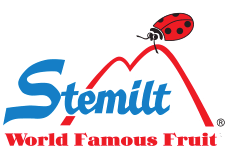The family behind Stemilt fruit
|
Now that you’ve been introduced to The Stem, I get the honor of publishing its second ever post and sharing a story with you that is very near to my heart. I’m Tate Mathison, a sales leader at Stemilt, dad to three busy boys, and most recently, a blogger that will share with you what’s happening on our farms. Stay tuned for a few farming posts from me once cherries start harvesting, and for now, enjoy the story of how my family came to be part of this great business.
Stemilt’s company roots trace back – way back – to 1893. That’s when my great-great grandfather Thomas Cyle Mathison, an immigrant from Scotland, homesteaded 160 acres on Stemilt Hill, a high-elevation region with lush soils that overlooks the Columbia River and town of Wenatchee, WA. The original homestead was a subsistence farm that produced the staples for the family (milk, meat, eggs, etc.) and enough wheat to sell to others and make a living. Then, when the railroad came through Wenatchee in the mid-1900’s, Thomas Cyle planted our family’s first 10 acres of cherries, apples, and pears.
Years later, Thomas Cyle passed away and left the farm to his son, Chris. Chris and his wife, A.J., were the parents of four young children, including a set of twins, Helen and Thomas Kyle or “T.K.” as he was nicknamed. This was the 1920’s and the life of a farming family was full of hard work and challenges, but a determined Chris found a way to gradually expand the family’s fruit business over the years.
In 1947, T.K. returned home from World War II in hopes of studying horticulture in college. But just like many times to come in T.K.’s life, Mother Nature had different plans for him. Warm temperatures in February melted snow quickly and caused an irrigation dam on the farm to flood. T.K. worked feverishly with his father to shore up the dam, but the waters proved to be too strong and pulled Chris under. He drowned that day and T.K. was left to take care of his family and the farm.
T.K. learned first-hand during his tour in the South Pacific that you must pick up and carry on through difficult times. He took over the farm at age 20, married Grandma Lorraine, and started a family. Uncle Bob came first, my father Kyle the following year, and Aunt Lavonne the year after that. Needless to say, T.K. and Lorraine had their hands full!
The 1940’s and 1950’s were difficult years for fruit growers, and in 1958, T.K. found himself – and the family business – at a crossroads. You see, the family had long relied on the local cooperative to market their fruit. They would load cherries onto a railcar, ship them to terminal markets in the eastern states, and then sell them on delivery. Most of the railcars were not refrigerated, leaving the spoilage factor for perishable cherries very high, but never as high as in 1958. That year, T.K. made a mere $88 on his 127-ton cherry crop! With a large bank note to service, he simply couldn’t afford to have such low returns again, especially with a family to care for. Lorraine gave T.K. an ultimatum and even though I wasn’t born yet, I can just imagine her voice as she told him: “Tommy, you either improve this cherry business or go down and get a job at the local factory to support this family!” Luckily for our family, T.K. decided to go the hard route and set off to significantly change the way he took his fruit to market.
The following year, he followed the railcar shipment of his cherries to New York and witnessed just how poorly his fruit had arrived. He went to California and studied the operations of cherry growers there and realized they were in stark contrast to how fruit was harvested in Washington. In California, they picked cherries early in the morning, hydrocooled the cherries prior to packing, and kept them cold before and during shipment. Armed with this new information, T.K. returned to Washington to discuss better growing and shipping techniques with the grower cooperative. But, the cooperative showed no interest in making T.K.’s suggested changes.
So, T.K. made a bold – and risky – decision. He made the improvements on his own, and in 1961, entered the cherry packing business. He constructed a small packing facility on Stemilt Hill and started implementing the harvest and packing practices that he learned about in California. In his first year as a grower-packer, T.K. followed the railcar with his product to the same New York market that he had been a few years prior. There, his cherries sold for $40 per 20-pound box! More importantly, the Stemilt cherries were still firm, flavorful, and as one salesperson at the market told T.K., “they just shine like rubies.” The next year, a few neighbors asked T.K. to pack their cherries and he agreed. In 1964, T.K. formally incorporated his fruit growing and packing business as Stemilt Growers.
As you might expect, the story of how Stemilt came to be is one of my favorites to tell. Founding Stemilt was just the first of many successes in T.K. life as a grower, packer, and shipper of fresh fruits. I have so many more T.K. stories that I could keep you reading this blog for days! T.K. (or grandpa to me) was sharp, determined, hard-working, and a visionary. He was an incredible role model to me and many of those that were fortunate to know him. T.K. passed away in 2008, but his legacy continues to live on at Stemilt, and it’s my hope that’s always the case.
Today, my family remains very involved in the business and honestly, we wouldn’t have it any other way. My father, Kyle Mathison, grows cherries most months out of the year in places like Chile, California, and of course, the legendary Stemilt Hill where it all began. He’s a lot like T.K. in that, he isn’t afraid to take risks. Dad also has some pretty out-of-the-box farming practices (which I’ll be sure to share with you). My older brother, West Mathison, is the president of Stemilt and has been since 2005 when T.K. retired. Growing up, I worked alongside West in various roles on the farm and even at a young age, West was always the one in charge. To me, it’s very natural to have West lead our family business and I feel fortunate that I get to work with him each day.
Now, you know all about my family’s heritage and how Stemilt came to be. As this blog takes shape, one thing I hope you notice in each post is how much our family loves growing fruit. It drives us out of bed each morning, it’s what we know, and above all, it’s our passion.

